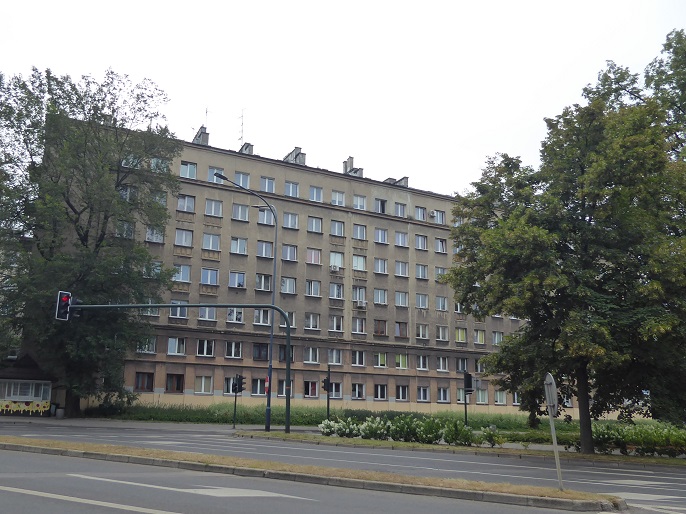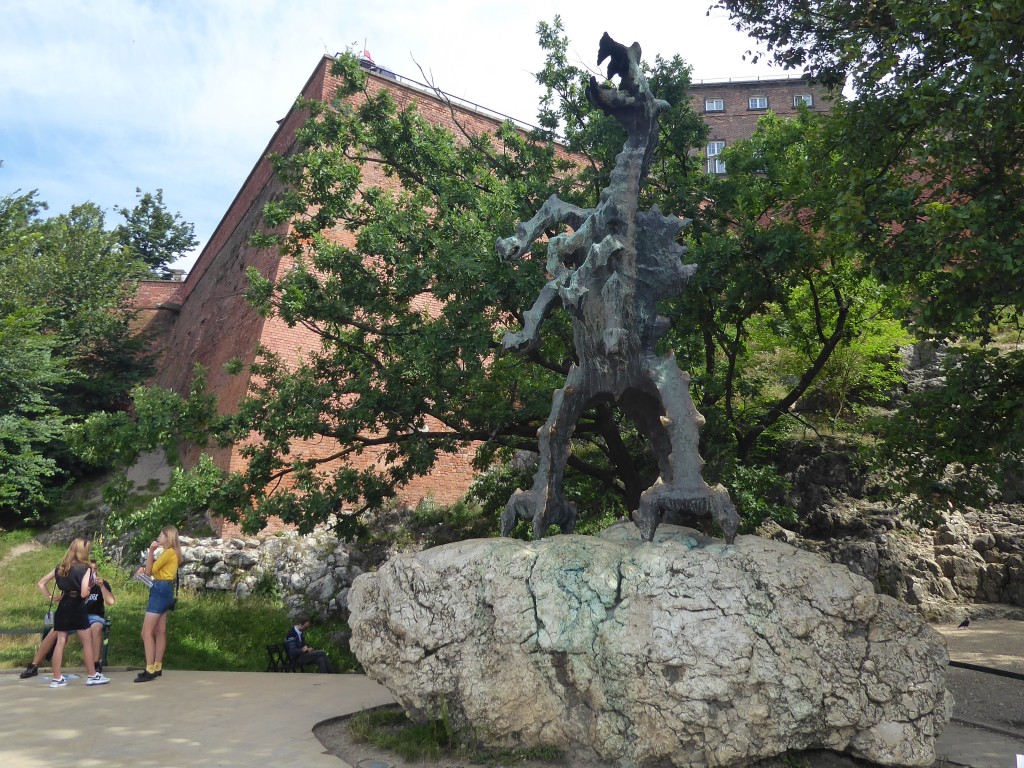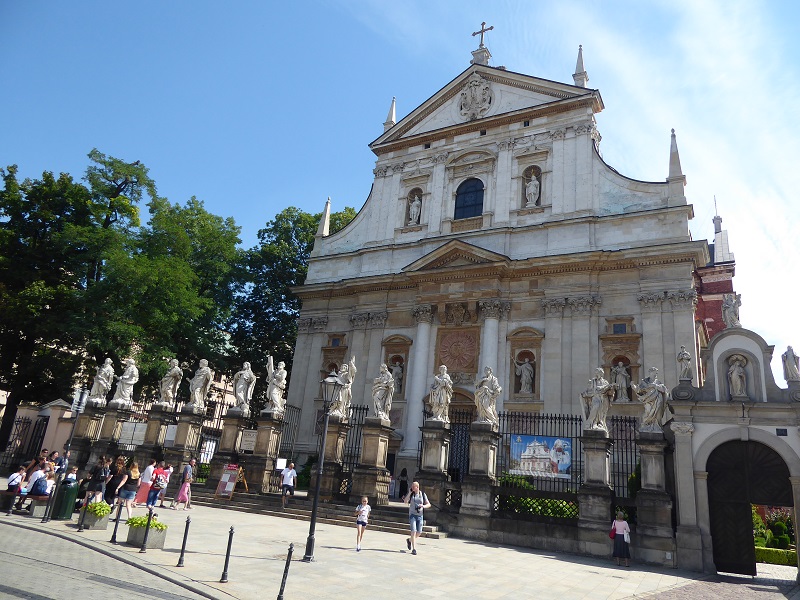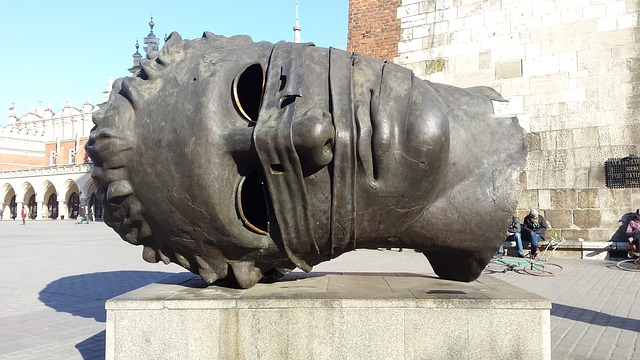We made a mistake with Kraków.

Our drive into Poland’s former royal capital took us on a journey back through time. Like the growth rings of a tree, modern outskirts encircle the old town, while in the centre, thousand-year-old buildings lie atop the site of a 50,000-year-old Palaeolithic settlement. Kraków’s many layers also mirror the history and changing fortunes of Poland.
Towering communist architecture loomed above us as we delved towards Kraków’s ancient heart. Brutalist and dark, like the regime, they exuded an obstinate, stark beauty. As we approached the Vistula river, the views opened up to reveal a limestone outcrop topped by the vast battlements and towers of the Wawel Royal Castle. Along with Kraków’s Old Town, this was the world’s very first UNESCO World Heritage Site.

The signage for the surface parking confused us as we looked for somewhere to leave our van, Big Blue. The square blue ‘P’ signs are pretty universal, but had the confusing addendum Płatny Koniec. Worried about what Terms and Conditions this might imply, we found the Wawel underground parking and abandoned Big Blue there. (I can now report that Płatny means ‘chargeable’ while Koniec means ‘end’!) Fully aware of our navigational shortcomings, even Mark and I were confident that we could find our way back. Wawel is one of Poland’s largest castles and visible from most parts of the city.

Dragon Street – ulica Smocza skirted the Wawel’s walls and followed a shimmering bend of the Vistula river. Kraków was founded on dragons and the 12th-Century Polish Chronicle tells of Smok Wawelski, a dragon who inhabited a limestone cave beneath the Wawel hill. Smok made a nuisance of himself by devouring sheep and local virgins, but here’s a question for you. How do you deal with a delinquent dragon?
To save you time, I have abridged the Paul Simon sonnet, 50 Ways to Slay a Dragon.
‘Spear it with a lance, Vance’ and ‘Pierce it with a sword, Claude’ pretty well cover numbers one through forty-seven. Dragon-dispatching aces Lancelot, Beowulf and St George were all disciples of Simon’s ‘Stab it in the back, Jack’ system.
At forty-eight comes ‘Hit it with a dart, Bart’. Arrows are the leading cause of death among dragons in Game of Thrones and The Hobbit.
However, a few mavericks made bold departures from mainstream methods of wasting a wayward wyvern. ‘Turn it to Stone, Tone’ was the method favoured by Perseus, who swooped in aboard Pegasus brandishing the severed head of the Medusa. Stony-faced and petrified, sea dragon Cetus could no longer harass Andromeda, tied naked to a rock as a sacrifice. Perseus claimed Andromeda as his bride and re-used the Gorgon’s head to get around the inconvenience that Andi was already engaged; he turned her fiancé to stone. He quickly petrified someone who was annoying Andi’s mum, then niftily disposed of his murdered murder weapon by presenting it as a nice gift for goddess Athena.
However, King Krakus and his sons, Princes Lech and Krakus II, top the podium for theatricality.
‘More Bang for your Buck, Chuck’ charts at fifty – and our princes certainly fought fire with fire. They fed Smok a sheep stuffed with smouldering sulphur. Unaware that Gaviscon might dampen his dyspepsia, Smok drank heartily from the river and blew up.
But the story didn’t end there. Lech killed Krakus and blamed the dragon. He was rumbled once he became king, however, so the city founded on the detonated dragon’s lair took the name of his brother. Or dad.
An alternative legend concerns shoemaker Skuba, although cordwainers killing dragons might be cobblers.
You can visit the Dragon’s Cave beneath the castle. As we walked past, a metal sculpture of Smok delighted the crowd by breathing fire every few minutes. Bones of prehistoric creatures, allegedly a dragon, adorn the exterior of the Wawel Cathedral. If they ever fall to the ground, the world will end.


Dogs could not go inside the Wawel precinct, so with four in tow, we admired the immense structure from the outside and continued on our quest to find the Old Town. Mark had diligently researched our tour and marked everything we wanted to see on a map. His hard work is invaluable when we explore a new city, but only when he remembers to bring the map along.

As we hit the road junction beyond the Wawel, I took a guess,
“I reckon it’s left for the city centre.”
“I think it’s right,” he insisted.
Since our second date, I have known that Mark has a superpower. I noticed it when he took a shortcut to avoid a traffic jam in his home town, where he’d lived man and boy. Quietly, I questioned myself. It seemed we’d followed three sides of a square, but I bowed to his superior local knowledge. I kept a straight face when we emerged half a mile further back in the same traffic jam, having discovered that although two wrongs don’t make a right, three lefts certainly do. Mark, it seems, is even more directionally challenged than I.
Since Mark had been staring at maps of Kraków for weeks, I stupidly overlooked his superpower. He did not disappoint. Few visitors to Kraków will see the unique and unforgettable sights we took in; a busy, four-lane road junction, a three-wheeled van advertising the unmissable Kraków Pinball Museum, and a café which claimed to offer at least two items on a menu advertising ‘Coffee; Tea; Cocaine’.


Enquiries with passers-by revealed we were en route to Kazimierz – Kraków’s Jewish quarter; exactly one-hundred-and-eighty degrees off course.

Twenty years after our second date, I still maintained a tactful silence as we retraced our steps towards the Old Town and the map-restoring opportunities offered by the Tourist Information Office. I could claim it was solidarity following the incident that slightly preceded the aforementioned traffic jam and superpower revalations. Mark had also maintained a poker face when I rushed to the bathroom, hacking like a cat with fur balls. I was trying to hide that I was choking on a fish bone from the sea bass that he had lovingly poached in white wine as an impressive pre-theatre supper. On my way back to our tryst, I slipped on the top stair and slid down the full flight on my backside.
“What was that noise?” he asked when I sashayed gracefully back into the romance of the dining room.
“Nothing!” I said, as I deployed my most coquettish smile and hair flick combo.
“It sounded like someone falling down the stairs!”
“Did it? Ha ha ha hack hack hack.” Ever the gentleman, he did not pursue the subject.
He left me with my dignity intact; a lesson I’ve not forgotten.
The lesson being that silence can say so much more than words.
Although truthfully, rather than preserving Mark’s dignity with a smirk and silence, I was busy staring open-mouthed at the stunning ancient architecture that bordered our route towards Rynek Główny, one of the largest market squares in Europe. With each side measuring two-hundred metres, the square encloses an area of nearly 9.4 acres.

Most of Poland’s major cities were rebuilt following absolute destruction in WWII, but Kraków survived the war relatively unscathed. Previously, the accepted wisdom was that, led by Marshall Ivan Konev, the Soviet Red Army took the Nazis by surprise when they attacked and liberated Kraków. However, recently discovered documents suggest that because of the risk of being surrounded, the Germans never intended to defend Kraków. Instead, they mined bridges to preserve their line of retreat and hinder the Red Army’s advance towards Poland’s industrial heartlands, which were critical to the Nazi war effort.

As we wandered up Grodzka, our first notably historic encounter was the 15th-Century Baroque church of St Peter and Paul. Its domed roofline dwarfed the octagonal twin towers of its Romanesque older neighbour, St Andrew’s church and monastery, which pre-dates Peter and Paul by five centuries. One of the oldest buildings in Kraków, St Andrew’s is a rare example of a fortified church, which provided refuge when the city was under attack. St Andrew’s was the only church to survive the devastating Mongol invasion of 1241.

After a quick dive into the Tourist Information, we repaired to the shady pavement umbrellas of café Slodki Wentzl in the main square to study our newly acquired map. There, we re-planned our city tour and enjoyed the best coffee of our trip so far, with a sliver of Cracow Cheesecake on the side. (Cracow is the Anglicised version of the city’s name.) Although it didn’t make the cut for the Sound of Music song, baked cheesecake is a few of my favourite things.
“It tastes like Prussic acid,” was Uncle Norman’s appraisal of my signature speciality; baked lemon cheesecake on an Amaretti biscuit base.
After a long afternoon in the kitchen, “Hydrogen cyanide” was not the reaction I expected.
Thankfully, Sernik Babci, the famous and delicious Polish curd-cheese classic does not share that tang of bitter almonds with cyanide-based poisons, plastic explosives or gangrene. If only the dragon slayers had known about my cheesecake!
As we savoured our slices, we drank in the quintessential vista of the square. I know it was the quintessential vista, since it matched the panorama emblazoned on the sides of electric council vehicles, which were buzzing around to empty the bins and so forth.

Like so many Polish cities, colourful, four-storey Renaissance and Baroque town houses surround the market square, which was rebuilt in 1257, following the aforementioned Mongol invasion and sacking. Today, many of the the medieval cellars have been converted into subterranean bars and bistros.
The layout of the buildings within the square has changed over the centuries. We found evidence of this immediately as we stepped away from our coffee and cheesecake. The seventy-metre gothic clock tower, constructed from red brick and white stone, is all that remains of the old town hall. Dating back to the 14th century, it was one of Poland’s oldest seats of government, but was demolished in 1820 to open up the square. If you have a head for heights, you can enjoy a bird’s-eye view over Kraków from the top.
Talking of heads, you will find one of Kraków’s weirdest landmarks next to the tower. A popular meeting place, The Head is a massive bronze sculpture of a hollow, bodiless bonce, bound with bandages and laid on its side. Created by Igor Mitoraj, this rather eerie artwork is Eros Bendato – Eros Bound. It is the neck and noddle of the Greek god of love, depicted as though it were a fragment from a toppled ancient monument.

In case you think, “What’s that all about?” interpretations vary.
As a highly erudite art critic, I can reveal that the figure represents someone who was accidentally decapitated in a game of Blind Man’s Buff. It was placed there by the Health and Safety Executive as a warning to us all.
However, pseudo-philosophers have come up with all kinds of ludicrous explanations. Some say the blindfold symbolises that love is blind. Others that the hollow eyes are a window to the darkness within, or that the bindings show the imprisonment of ideas and desires. Another theory is that it explores the paradox of whether civilisation is broken beyond repair, or held together despite destructive powers. Or perhaps that it represents the suffering of the artist’s home country, Poland, throughout its troubled history.
Whatever it is, if you want to see where else Eros was bound, you can come face to face with a copy of the corpseless cranium in St. Louis (home of Lambert International Airport!), Vancouver and Lugano, Switzerland.

Whether you’re Usain Bolt or just need a hundred-metre dash to work off all that cheesecake and culture, the length of one of the city’s most iconic buildings is conveniently pre-calibrated. The Cloth Hall – Sukiennice, has been a centre of commerce for over seven centuries. It has undergone several rebuilds, with its characteristic stone arcades added in the late 19th century. On the ground floor, you will find market stalls selling reasonably-priced souvenirs, with an underground museum beneath and an art gallery and café above.

The sight of magnificent horse-drawn carriages drew me towards their taxi rank between the Cloth Hall and the twin towers of Kościół Mariacki – Saint Mary’s Church. Consecrated in 1320, St Mary’s gothic towers are noticeably asymmetric. Legend has it that another pair of belligerent brothers built them, but in a classic, “Mine’s bigger than yours!” argument, one allegedly stabbed the other before turning the knife on himself. Don’t believe it? The knife is on display in the Sukiennice – although, as with any good legend, the knife might be there as a reminder to Kraków’s population that crime was punishable by death. I think Paul Simon missed a trick here; Fifty Ways to Cleave Your Brother has commercial success written all over it.
Every hour, the five-note Hejnał mariacki – St Mary’s Trumpet Call toots four times from the top of the taller tower. The call goes out to each point of the compass, although it is cut short to commemorate the trumpeter shot in the throat as he called the alarm to warn of the fabled Mongol attack. This legend inspired The Trumpeter of Kraków by Eric P. Kelly.
The Hejnał is to Poles as the chiming of Big Ben is to Brits. They broadcast the noon trumpet call live on Polish national radio. Noon is also the time when St Mary’s Gothic altarpiece is unveiled. One of the largest in Europe, it was carved in the late 1400s by renowned German sculptor and Kraków resident, Veit Stoss.

Past the obligatory Irish Pub, we found ourselves at the Barbican, one of the last remaining parts of the old defensive walls. This circular, moated brick building with seven watch towers dates back to the late 1400s and has walls three metres thick. It saw active service through many sieges, and was as once connected to the Florianska Gate, the principal of the seven entrances into the city. The Florianska gate is the start of Kraków’s Royal Route, which we had unknowingly trekked in reverse from the Wawel.
In need of respite from the brilliance of sun and history, we looped back to the Wawel via the Platny gardens. These surround the old town and follow the path of the city’s former defensive walls and moat. The trees were planted in the 1800s when the walls were demolished and the moat filled in. It was less relaxing than it might have been due to the hipster scourge of electric scooters whizzing past. Like the Mongol invaders, they were relentless and gave no quarter.
Although we had barely scraped the surface of the Old Town and hadn’t even made the Jewish Quarter to see the Oskar Schindler factory and remains of the ghetto, we called it a day. It was then that we realised our mistake. It wasn’t misinterpreting parking signs, getting lost or forgetting our map. The simple truth is that you need more than a day to see Kraków!
Koniec!

Photo Credit – Wawel by Corinne Cavallo on Flickr Creative Commons Licence BY2.0
What Else to Do in Kraków
Click here for the best list that I found of 30 things to do in and around Krakow.
Cheesecake Recipes
Click here for a few delicious Polish Cheesecake recipes. In case you want to try my delicious Baked Lemon Cheesecake, here is the recipe:
Prussic Acid Cheesecake
- 75g (3oz) Butter
- 110g (4oz) Digestive Biscuits, crushed
- 50g (2oz) Amaretti Biscuits, crushed
- 3 drops Almond Essence
- 170g (6oz) tub Cottage Cheese
- 250g (9oz) tub Ricotta Cheese
- 75g (3oz) Caster Sugar
- 25g (1oz) Cornflour
- 1 Lemon, grated rind
- 150ml (5 fl oz) Sour Cream
- 2 Eggs, separated
- 75g (3oz) Sultanas
- Melt the butter in a pan and stir in the crushed biscuits and almond essence. Press into the base of a deep 20cm (8″) dish.
- Blend together all the cheeses, add the sugar, cornflour, lemon rind, sour cream and egg yolks.
- Whisk the egg whites until stiff, then fold into the cheese mixture with the sultanas. Pour the filling over the biscuit base.
- Bake at 180C, 350F, Gas Mark 4 for 40-45 minutes, until set and golden brown. Cool, then chill well.
- Serve dusted lightly with icing sugar, decorated with lemon slices and with cream if you like.
- Await flattering comments from Uncle Norman.

😄🐲 Entertaining as always.
LikeLiked by 1 person
The photo’s of all those churches are really beautiful … but the cherry on the cake must be the horse-drawn carriages in front of McDonalds 😁.
Lovely and entertaining post 💌
LikeLiked by 1 person
Pleased you enjoyed it! 🙂
LikeLike
This raises a question for me that I have pondered for a while and you might be able to answer it. Can you buy cream cheese (Philadelphia in particular) in the block form in the UK? I have only been able to buy the spread. I have an awesome recipe for a Guinness brownie with cream cheese icing/frosting and the spreadable version makes the icing too runny. I see that your cheesecake recipe doesn’t use cream cheese. Thanks ❤️✨
LikeLiked by 2 people
The recipe for the brownies is from this website but I don’t use their icing/frosting recipe https://sallysbakingaddiction.com/guinness-brownies/
LikeLiked by 1 person
Mwa ha ha! I’m going to be making lockdown Guinness brownies. Thank you! 🙂
LikeLiked by 1 person
You will LOVE them!!!
LikeLiked by 1 person
I have never come across blocks of Philadelphia and checking their UK product page, I can’t see it on there I’m afraid. https://www.philadelphia.co.uk/products
I did a quick search and I think we perhaps use different terminology ‘soft white cheese’ for cream cheese according to this article. https://www.nigella.com/ask/cream-cheese-for-cheesecake
I hope that helps – let me know how you get on. And please share your recipe! Guinness and choc brownie sounds AWESOME! It would be a great post-SUP sanck! 🙂
LikeLiked by 1 person
You might find this article helpful!
It suggests that blocks are not available in the UK but provides a hack to stop your frosting from being too runny! https://kerrycooks.com/foolproof-thick-cream-cheese-frosting-recipe/
LikeLiked by 1 person
Thanks for that, it makes sense to try draining the excess moisture out. I usually make the icing out of my head with just butter, spreadable Philadelphia and icing sugar but adding some lemon juice or vanilla essence would work too.
LikeLiked by 1 person
You are truly hilarious. Thanks for making me laugh. I loved the 50 ways to kill your dragon. I have a good friend who is from Poland. He might be getting married soon, so that would be an ideal excuse to fly over to Poland (once we can fly again, of course). I’ll be reading the rest of your Polish excursions with interest.
I haven’t gone through your whole blog, but wanted to ask about your van. Is it a camper?
LikeLiked by 2 people
Thank you so much for your kind words. It always cheers my day to know that someone had enjoyed my ramblings!
I hope we can all travel again soon and I do hope you make it to Poland. There is so much to see.
We tour in a caravan/trailer towed by a Hyundai iLoad panel van. We carry a lot of windsurfing equipment, bikes and doggie trailers, so the van comes in useful as a toy box! We did originally look at motorhomes/campervans, but they didn’t fit all our sports kit, weren’t big enough for Mark who is 6’6″ (2m) tall and were much more costly to buy and run. That said, we will be moving into a converted Volvo N10 truck this year!
If you want the low down on our vehicles, this is a good place to start. https://worldwidewalkies.blog/vehicles/
Thanks for dropping by! I shall be dropping in on your blog shortly! 🙂
LikeLiked by 2 people
Hi, Thanks so much for all your great info and the link. I like the idea of a travel trailer. So much more room. We’ve had our van since 2000. I agree – the campervans are very expensive, for no real good reason either. I understand why so many people build their own.
Enjoy your travels! Alisen
LikeLiked by 2 people
Płatny Koniec. You made my day 🙂 🙂 🙂 Nice blog BTW!
LikeLiked by 1 person
Hi Kuba! Nice to meet you in this part of Cyberspace! We thought about you while we were in Krakow. Are you related to the Dragon Slayers?!
LikeLiked by 1 person
Hi there, we enjoyed your post. It brought back wonderful memories of our stay in Krakow. We visited for a few days between Christmas and New Year, our flight home was cancelled so we ended staying for the new year celebrations, we had a lot of fun there. 😁
LikeLiked by 2 people
Thank you! I am so pleased you enjoyed the read.
Krakow is certainly a vibrant city – there are worse places to be stuck. 🙂
Glad you made it back safely – it’s been a curious year for travel!
LikeLiked by 2 people
It was Christmas 2016 when we were there. And yes, the last year has been unusual although we managed a fair bit of travel under the circumstances. Lets hope we can all get going again soon 🙂
LikeLiked by 2 people
Sorry – I just assumed it was a Covid cancellation! Yes – I can’t wait to get back on the road again. Hopefully in May. In the meantime, I’m just re-living our last year because I write much more slowly than I travel!
LikeLiked by 1 person